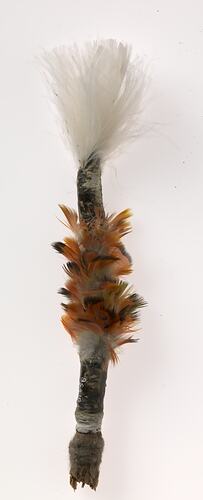Summary
The ceremonial beard is set onto the chin of a senior man for a sacred ceremony and thus worn like a beard. Breast feathers of the red-collared lorikeet have been embedded into this beard and the string is made of possum fur. These were made for and worn by senior men for ceremonies, and is actually attached to an existing beard. Senior ceremonial leaders and men of great power sported a 'goatee' type beard to denote their status, and this is thought to have been an influence of the Macassans as they appear to mimic those worn by the captains of the Macassan fleets. The anthropologist Donald Thomson recorded the term 'dhuwurr bulumbul' for this beard, the first word meaning custom and the second being white or grey hair, indicating it was a custom associated with old men.
Local Name
dhawarrak
Physical Description
A beard made of a central core of bark bound with possum fur string overlaid with beeswax and painted with white pipe clay. Coloured parrot feathers are embedded into the resin in the centre of the beard and a tuft of white feathers are attached to the distal end.
Significance
Question: Did Aboriginal people in Australia have any contact with other countries before European contact?
Answer: Yes!
The first European contact with the land we now know as Australia is generally held to have been by Dutch explorers in 1606. We know how important internal trading relationships and routes were to Indigenous peoples, but people are often not aware that a relationship developed between Aboriginal people in eastern Arnhem Land and visitors from overseas. Macassan people from what is now known as Sulawesi (Indonesia) annually visited the northern shores of Australia, the place they called Marege'. Whilst some people believe regular trade started in the early 1700s, others claim that these relationships go back several centuries before European contact, to the 1400s or before.
The Macassans came on the north-west winds that brought the monsoonal rains. They went in search of trepang or sea cucumber, an item valued for both food and medicinal purposes; in exchange for fishing rights, Yolngu were given goods such as cloth, tobacco, rice and knives. The trepang was processed on the shores of Australia; the Macassans then shipped the trepang home, with some of the product being traded as far as mainland China. Rock art found in the Wellington Ranges and on Groote Eylandt in Arnhem Land depicts the prau, the distinctive wooden vessels used for these voyages.
A great deal of cultural exchange occurred between Yolngu and Macassans, and Yolngu worked for the Macassans and even travelled between Macassar and Australia. This had a lasting impact on the local culture and language, with place names and words like rupiah (money) and balanda (white person) being from the Macassan language. Oral histories, ceremonial practices and the song cycles from that area reflect the exchange of knowledge and objects between Yolngu and Macassans. Evidence of the influences survive in Yolngu technologies such as making dugout canoes and metal-working.
In areas where the Macassan traders visited the physical evidence of their seasonal visits can be seen in the stands of tamarind trees (not indigenous to Australia) and remnants of camps found in the form of stones where trepang was boiled and cured on the beaches. Visits by Macassans were banned in 1906 when the Commonwealth took over the administration of the Northern Territory. Allen, Lindy for Collections Online: Article: Aboriginal People & Trade
More Information
-
Object/Medium
Ornament, head
-
Maker
-
Cultural Groups
-
Locality
Blue Mud Bay, Eastern Arnhem Land, Northern Territory, Australia
-
Date Produced
-
Collector
-
Date Collected
-
Object Measurements
190 mm (Length), 70 mm (Width), 50 mm (Height)
-
Classification
-
Date Made
-
Maker
-
Clan/Language Group
-
Place Made
-
Indigenous Region
-
Keywords
-
Acquisition Information
Long-term Loan from The University of Melbourne, 28 Mar 1973
-
Collection Names
-
Type of item
-
Discipline
-
Category
-
Acknowledgement
The Donald Thomson Collection. On loan to Museum Victoria from The University of Melbourne.
